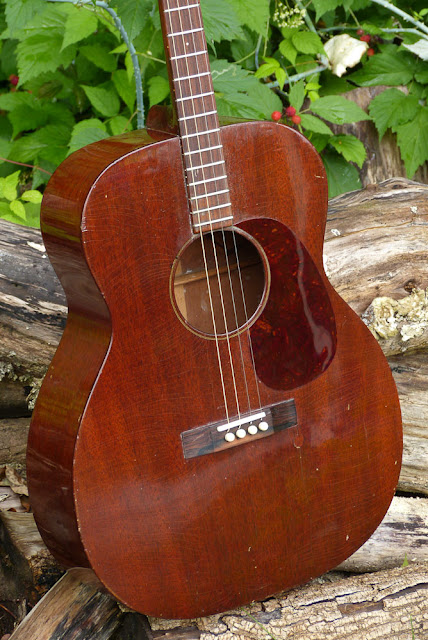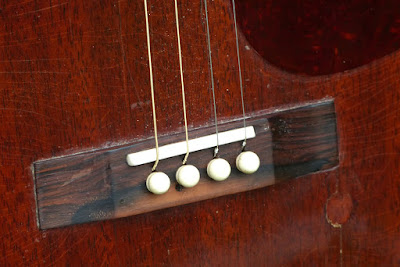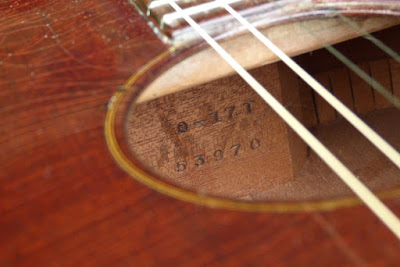1933 Martin 0-17T Tenor Guitar
I have to admit that when this guitar first came in I wasn't that impressed with its tone. Fortunately, that all disappeared as soon as work was done! This thing's now a go-getter with full, out-front, delicious "hog top" Martin appeal. This is a consignment guitar and I'm glad I had the chance to breathe some new life into it, as the last work done on it just wasn't up to snuff to make it a player (or to make it easy on the ears).
These 30s Martins just sound great when they're dolled-up and the lighter bracing and lighter overall build certainly help. The 23" scale puts snappy tension on the strings, but because the mahogany tops are much more mids-centric, I think that 0-17T and 0-15T models are still best utilized for CGDA or DGBE tunings compared to "Celtic" GDAE tuning. I've got this one currently strung-up with the DGBE strings of a standard "12s" guitar set and it's loving it. Can we say "Delmore Brothers?"
My work included a fret level/dress, bridge saddle slot modification, new saddle and nut, new pickguard (to replace a fairly sloppy replacement pickguard), and general setup. It plays great with a straight neck and 1/16" action at the 12th fret. That's right on the dot.
It has some older repairs including two smallish hairline crack repairs, 3 patches in the wood (2 in the side and one on the top next to the bridge), a replacement bridge (which, when it came in, was pretty funky), and a coat of nitro overspray to the whole body and the back of the neck. The frets were also replaced a while back but the person who did the job didn't level the board first! Ugh.
That meant that a lot of height had been leveled off of the "new" old frets to try to ameliorate that but even then they still weren't level. I did the rest of the leveling and while the frets are bigger side-to-side and low-ish in height, they've still got juice left. They're actually probably about the same height (now) as the original frets when new.
Thankfully, the back of the headstock and the front of the headstock weren't hit with new finish. The new finish doesn't look too shabby, though, because it was sprayed over the old finish and thus didn't kill the vintage vibe.
That's a new bone nut I whipped up.
Both the board and headstock veneer are Brazilian rosewood. As typical for style 17, the dots are cream celluloid and tiny. I've always liked the look.
My new pickguard is perhaps a bit more 40s/50s in color but I think it looks grand on this old girl. The single-ring rosette is, as usual for Martin, an understated piece of finery.
The replacement (Brazilian) bridge was cut with a straight saddle. Grr! Fortunately I could enlarge the slot to the rear slightly and fit a new, compensated saddle to get intonation decent. I then reamed the pin holes slightly larger and fit some antique celluloid bridge pins to keep it looking more "in era." This had cruddy new plastic pins installed.
Note the "patch" behind the bridge and a tiny hairline crack (fixed) next to it. Someone maybe had some volume control there?
There's weather-check in the finish all over so it looks nicely vintage (as it should). The only cracks on the guitar are two smaller hairlines on the front which are stable and either over bracing (and thus cleated by default) directly or fixed.
The old geared tuners are working just fine.
The neck set is good to go.
There's use-wear -- little nicks and dings -- here and there all over. It's not distracting, though.
The wooden endpin isn't original but it does serve. Note the two patches to the sides down here -- probably more electronics ports.
The guitar also comes with an older (40s? 50s?) chip case in functional shape.






















Comments